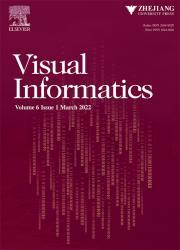ChemNav: An interactive visual tool to navigate in the latent space for chemical molecules discovery
IF 3.8
3区 计算机科学
Q2 COMPUTER SCIENCE, INFORMATION SYSTEMS
引用次数: 0
Abstract
In recent years, AI-driven drug development has emerged as a prominent research topic in computer chemistry. A key focus is the application of generative models for molecule synthesis, which create extensive virtual libraries of chemical molecules based on latent spaces. However, locating molecules with desirable properties within the vast latent spaces remains a significant challenge. Large regions of invalid samples in the latent space, called “dead zones”, can impede the exploration efficiency. The process is always time-consuming and repetitive. Therefore, we aim to propose a visualization system to help experts identify potential molecules with desirable properties as they wander in the latent space. Specifically, we conducted a literature survey about the application of generative networks in drug synthesis to summarize the tasks and followed this with expert interviews to determine their requirements. Based on the above requirements, we introduce ChemNav, an interactive visual tool for navigating latent space for desirable molecules search. ChemNav incorporates a heuristic latent space interpolation path search algorithm to enhance the efficiency of valid molecule generation, and a similar sample search algorithm to accelerate the discovery of similar molecules. Evaluations of ChemNav through two case studies, a user study, and experiments demonstrated its effectiveness in inspiring researchers to explore the latent space for chemical molecule discovery.
ChemNav:一个交互式可视化工具,用于在化学分子发现的潜在空间中导航
近年来,人工智能驱动的药物开发已成为计算机化学领域的一个突出研究课题。一个关键的焦点是分子合成生成模型的应用,它基于潜在空间创建了广泛的化学分子虚拟库。然而,在巨大的潜在空间中定位具有理想特性的分子仍然是一个重大挑战。潜在空间中存在大面积无效样本,称为“死区”,会影响探测效率。这个过程总是费时且重复的。因此,我们的目标是提出一个可视化系统,以帮助专家识别潜在分子在潜在空间中漫游时具有理想特性。具体来说,我们对生成网络在药物合成中的应用进行了文献调查,总结了任务,然后与专家进行了访谈,以确定他们的要求。基于上述需求,我们介绍了ChemNav,一个交互式可视化工具,用于导航潜在空间,以进行所需分子的搜索。ChemNav结合了一种启发式潜在空间插值路径搜索算法来提高有效分子生成的效率,以及一种相似样本搜索算法来加速相似分子的发现。通过两个案例研究、一个用户研究和实验对ChemNav进行了评估,证明了它在激励研究人员探索化学分子发现的潜在空间方面的有效性。
本文章由计算机程序翻译,如有差异,请以英文原文为准。
求助全文
约1分钟内获得全文
求助全文
来源期刊

Visual Informatics
Computer Science-Computer Graphics and Computer-Aided Design
CiteScore
6.70
自引率
3.30%
发文量
33
审稿时长
79 days
 求助内容:
求助内容: 应助结果提醒方式:
应助结果提醒方式:


